warning CADILLAC ESCALADE 2021 Service Manual
[x] Cancel search | Manufacturer: CADILLAC, Model Year: 2021, Model line: ESCALADE, Model: CADILLAC ESCALADE 2021Pages: 492, PDF Size: 7.92 MB
Page 81 of 492
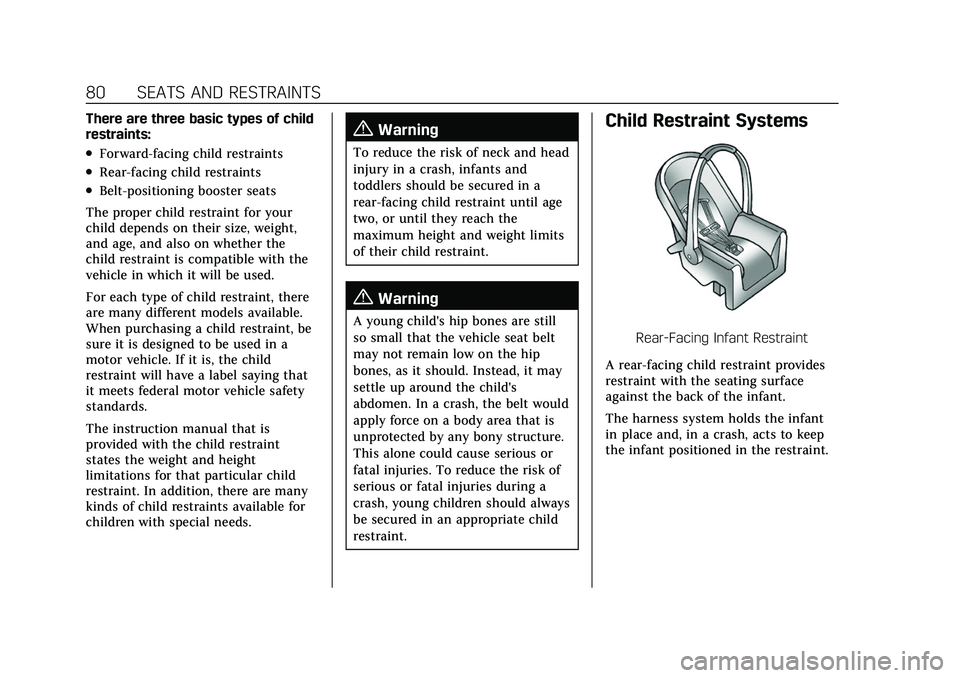
Cadillac Escalade Owner Manual (GMNA-Localizing-U.S./Canada/Mexico-
13690472) - 2021 - CRC - 8/10/21
80 SEATS AND RESTRAINTS
There are three basic types of child
restraints:
.Forward-facing child restraints
.Rear-facing child restraints
.Belt-positioning booster seats
The proper child restraint for your
child depends on their size, weight,
and age, and also on whether the
child restraint is compatible with the
vehicle in which it will be used.
For each type of child restraint, there
are many different models available.
When purchasing a child restraint, be
sure it is designed to be used in a
motor vehicle. If it is, the child
restraint will have a label saying that
it meets federal motor vehicle safety
standards.
The instruction manual that is
provided with the child restraint
states the weight and height
limitations for that particular child
restraint. In addition, there are many
kinds of child restraints available for
children with special needs.
{Warning
To reduce the risk of neck and head
injury in a crash, infants and
toddlers should be secured in a
rear-facing child restraint until age
two, or until they reach the
maximum height and weight limits
of their child restraint.
{Warning
A young child's hip bones are still
so small that the vehicle seat belt
may not remain low on the hip
bones, as it should. Instead, it may
settle up around the child's
abdomen. In a crash, the belt would
apply force on a body area that is
unprotected by any bony structure.
This alone could cause serious or
fatal injuries. To reduce the risk of
serious or fatal injuries during a
crash, young children should always
be secured in an appropriate child
restraint.
Child Restraint Systems
Rear-Facing Infant Restraint
A rear-facing child restraint provides
restraint with the seating surface
against the back of the infant.
The harness system holds the infant
in place and, in a crash, acts to keep
the infant positioned in the restraint.
Page 82 of 492
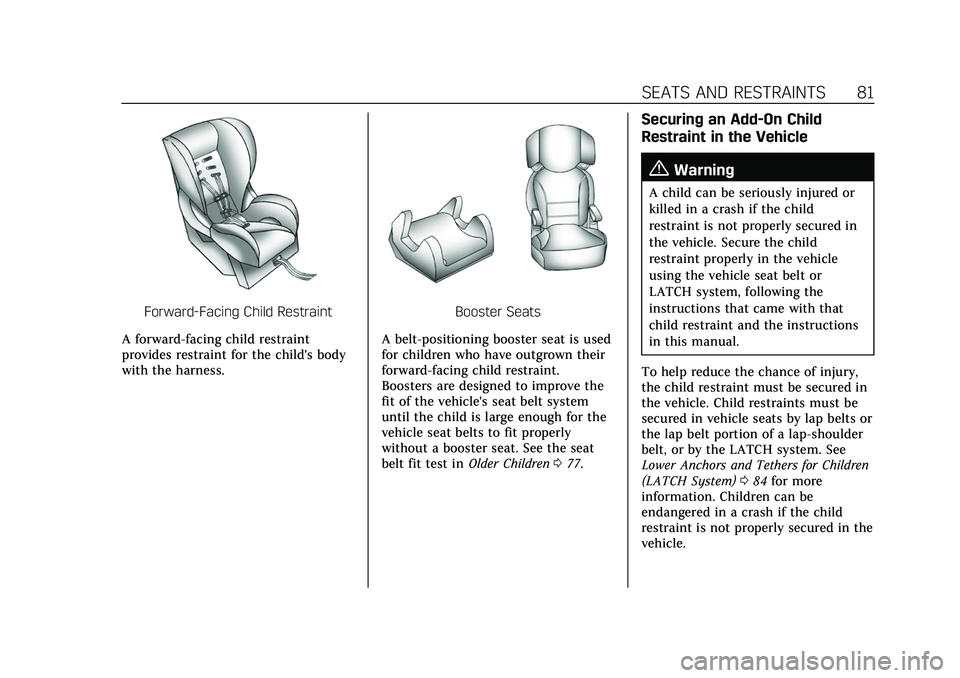
Cadillac Escalade Owner Manual (GMNA-Localizing-U.S./Canada/Mexico-
13690472) - 2021 - CRC - 8/10/21
SEATS AND RESTRAINTS 81
Forward-Facing Child Restraint
A forward-facing child restraint
provides restraint for the child's body
with the harness.Booster Seats
A belt-positioning booster seat is used
for children who have outgrown their
forward-facing child restraint.
Boosters are designed to improve the
fit of the vehicle's seat belt system
until the child is large enough for the
vehicle seat belts to fit properly
without a booster seat. See the seat
belt fit test in Older Children077.
Securing an Add-On Child
Restraint in the Vehicle
{Warning
A child can be seriously injured or
killed in a crash if the child
restraint is not properly secured in
the vehicle. Secure the child
restraint properly in the vehicle
using the vehicle seat belt or
LATCH system, following the
instructions that came with that
child restraint and the instructions
in this manual.
To help reduce the chance of injury,
the child restraint must be secured in
the vehicle. Child restraints must be
secured in vehicle seats by lap belts or
the lap belt portion of a lap-shoulder
belt, or by the LATCH system. See
Lower Anchors and Tethers for Children
(LATCH System) 084 for more
information. Children can be
endangered in a crash if the child
restraint is not properly secured in the
vehicle.
Page 83 of 492
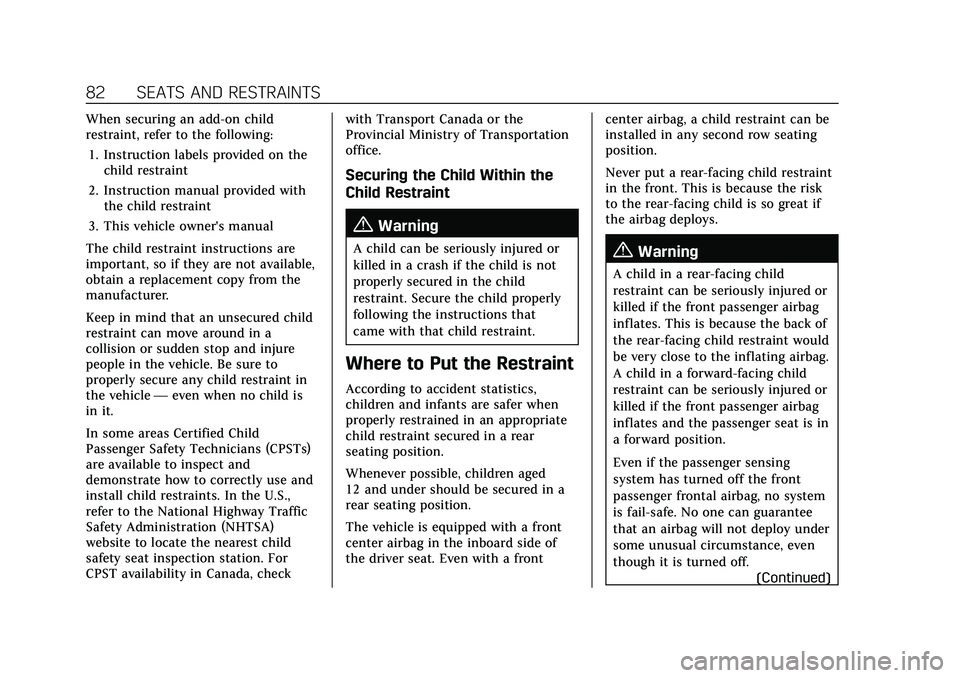
Cadillac Escalade Owner Manual (GMNA-Localizing-U.S./Canada/Mexico-
13690472) - 2021 - CRC - 8/10/21
82 SEATS AND RESTRAINTS
When securing an add-on child
restraint, refer to the following:1. Instruction labels provided on the child restraint
2. Instruction manual provided with the child restraint
3. This vehicle owner's manual
The child restraint instructions are
important, so if they are not available,
obtain a replacement copy from the
manufacturer.
Keep in mind that an unsecured child
restraint can move around in a
collision or sudden stop and injure
people in the vehicle. Be sure to
properly secure any child restraint in
the vehicle —even when no child is
in it.
In some areas Certified Child
Passenger Safety Technicians (CPSTs)
are available to inspect and
demonstrate how to correctly use and
install child restraints. In the U.S.,
refer to the National Highway Traffic
Safety Administration (NHTSA)
website to locate the nearest child
safety seat inspection station. For
CPST availability in Canada, check with Transport Canada or the
Provincial Ministry of Transportation
office.
Securing the Child Within the
Child Restraint
{Warning
A child can be seriously injured or
killed in a crash if the child is not
properly secured in the child
restraint. Secure the child properly
following the instructions that
came with that child restraint.
Where to Put the Restraint
According to accident statistics,
children and infants are safer when
properly restrained in an appropriate
child restraint secured in a rear
seating position.
Whenever possible, children aged
12 and under should be secured in a
rear seating position.
The vehicle is equipped with a front
center airbag in the inboard side of
the driver seat. Even with a front
center airbag, a child restraint can be
installed in any second row seating
position.
Never put a rear-facing child restraint
in the front. This is because the risk
to the rear-facing child is so great if
the airbag deploys.
{Warning
A child in a rear-facing child
restraint can be seriously injured or
killed if the front passenger airbag
inflates. This is because the back of
the rear-facing child restraint would
be very close to the inflating airbag.
A child in a forward-facing child
restraint can be seriously injured or
killed if the front passenger airbag
inflates and the passenger seat is in
a forward position.
Even if the passenger sensing
system has turned off the front
passenger frontal airbag, no system
is fail-safe. No one can guarantee
that an airbag will not deploy under
some unusual circumstance, even
though it is turned off.
(Continued)
Page 84 of 492
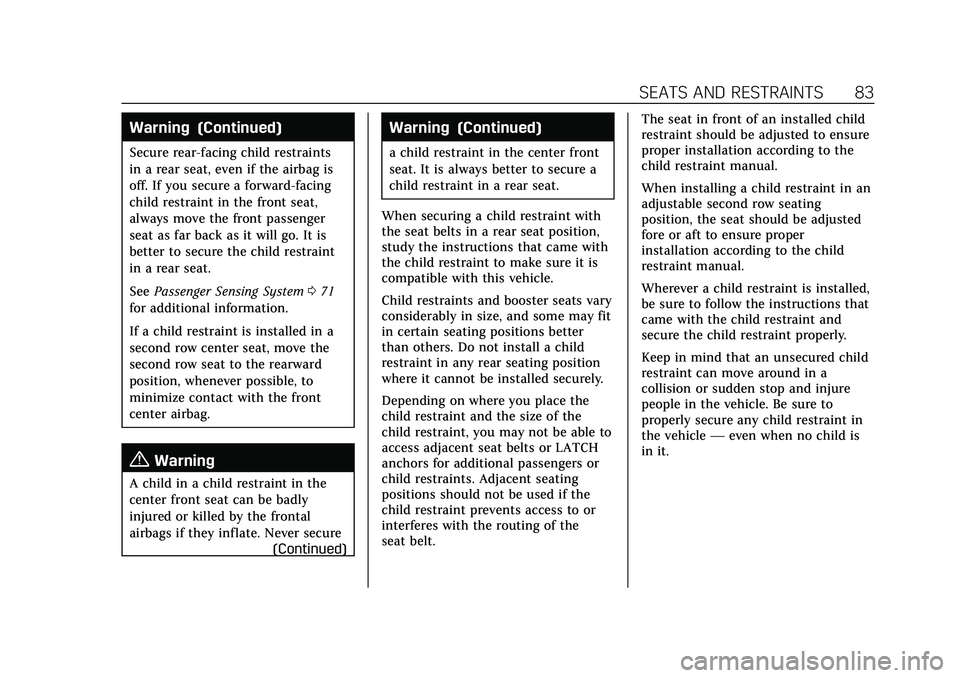
Cadillac Escalade Owner Manual (GMNA-Localizing-U.S./Canada/Mexico-
13690472) - 2021 - CRC - 8/10/21
SEATS AND RESTRAINTS 83
Warning (Continued)
Secure rear-facing child restraints
in a rear seat, even if the airbag is
off. If you secure a forward-facing
child restraint in the front seat,
always move the front passenger
seat as far back as it will go. It is
better to secure the child restraint
in a rear seat.
SeePassenger Sensing System 071
for additional information.
If a child restraint is installed in a
second row center seat, move the
second row seat to the rearward
position, whenever possible, to
minimize contact with the front
center airbag.
{Warning
A child in a child restraint in the
center front seat can be badly
injured or killed by the frontal
airbags if they inflate. Never secure (Continued)
Warning (Continued)
a child restraint in the center front
seat. It is always better to secure a
child restraint in a rear seat.
When securing a child restraint with
the seat belts in a rear seat position,
study the instructions that came with
the child restraint to make sure it is
compatible with this vehicle.
Child restraints and booster seats vary
considerably in size, and some may fit
in certain seating positions better
than others. Do not install a child
restraint in any rear seating position
where it cannot be installed securely.
Depending on where you place the
child restraint and the size of the
child restraint, you may not be able to
access adjacent seat belts or LATCH
anchors for additional passengers or
child restraints. Adjacent seating
positions should not be used if the
child restraint prevents access to or
interferes with the routing of the
seat belt. The seat in front of an installed child
restraint should be adjusted to ensure
proper installation according to the
child restraint manual.
When installing a child restraint in an
adjustable second row seating
position, the seat should be adjusted
fore or aft to ensure proper
installation according to the child
restraint manual.
Wherever a child restraint is installed,
be sure to follow the instructions that
came with the child restraint and
secure the child restraint properly.
Keep in mind that an unsecured child
restraint can move around in a
collision or sudden stop and injure
people in the vehicle. Be sure to
properly secure any child restraint in
the vehicle
—even when no child is
in it.
Page 90 of 492
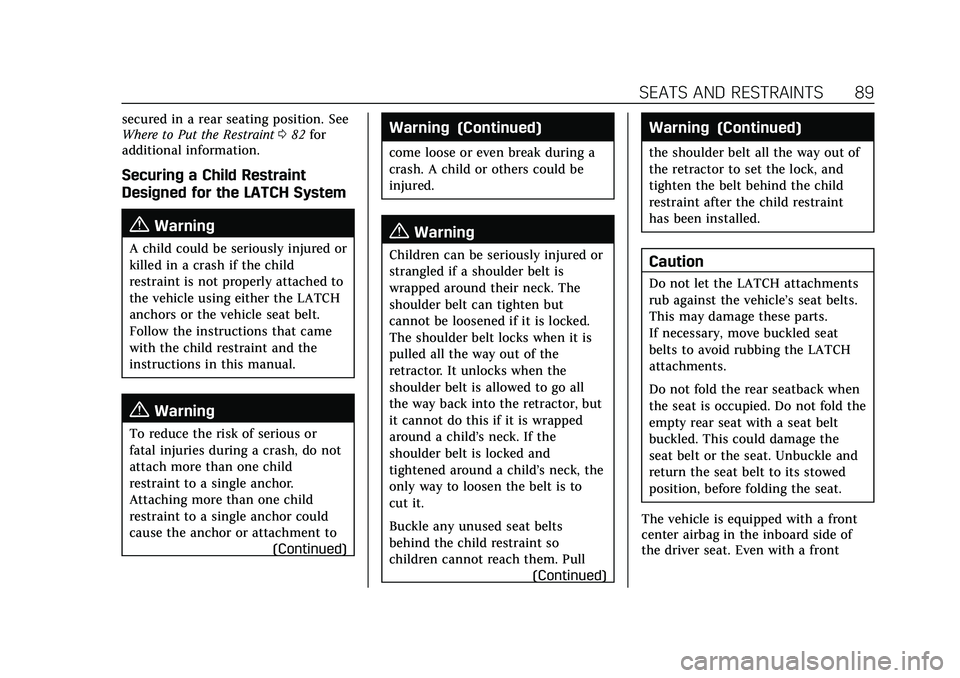
Cadillac Escalade Owner Manual (GMNA-Localizing-U.S./Canada/Mexico-
13690472) - 2021 - CRC - 8/10/21
SEATS AND RESTRAINTS 89
secured in a rear seating position. See
Where to Put the Restraint082 for
additional information.
Securing a Child Restraint
Designed for the LATCH System
{Warning
A child could be seriously injured or
killed in a crash if the child
restraint is not properly attached to
the vehicle using either the LATCH
anchors or the vehicle seat belt.
Follow the instructions that came
with the child restraint and the
instructions in this manual.
{Warning
To reduce the risk of serious or
fatal injuries during a crash, do not
attach more than one child
restraint to a single anchor.
Attaching more than one child
restraint to a single anchor could
cause the anchor or attachment to
(Continued)
Warning (Continued)
come loose or even break during a
crash. A child or others could be
injured.
{Warning
Children can be seriously injured or
strangled if a shoulder belt is
wrapped around their neck. The
shoulder belt can tighten but
cannot be loosened if it is locked.
The shoulder belt locks when it is
pulled all the way out of the
retractor. It unlocks when the
shoulder belt is allowed to go all
the way back into the retractor, but
it cannot do this if it is wrapped
around a child’s neck. If the
shoulder belt is locked and
tightened around a child’s neck, the
only way to loosen the belt is to
cut it.
Buckle any unused seat belts
behind the child restraint so
children cannot reach them. Pull(Continued)
Warning (Continued)
the shoulder belt all the way out of
the retractor to set the lock, and
tighten the belt behind the child
restraint after the child restraint
has been installed.
Caution
Do not let the LATCH attachments
rub against the vehicle’s seat belts.
This may damage these parts.
If necessary, move buckled seat
belts to avoid rubbing the LATCH
attachments.
Do not fold the rear seatback when
the seat is occupied. Do not fold the
empty rear seat with a seat belt
buckled. This could damage the
seat belt or the seat. Unbuckle and
return the seat belt to its stowed
position, before folding the seat.
The vehicle is equipped with a front
center airbag in the inboard side of
the driver seat. Even with a front
Page 92 of 492

Cadillac Escalade Owner Manual (GMNA-Localizing-U.S./Canada/Mexico-
13690472) - 2021 - CRC - 8/10/21
SEATS AND RESTRAINTS 91
single tether, route the tether
around the inboard side of the
headrest or head restraint.
If the position you are using
has a fixed or an adjustable
head restraint and you are
using a dual tether, route the
tether around the head
restraint.
3. Before placing a child in the child restraint, make sure it is securely
held in place. To check, grasp the
child restraint at the LATCH path
and attempt to move it side to side
and back and forth. There should
be no more than 2.5 cm (1 in) of
movement, for proper installation.
Replacing LATCH System
Parts After a Crash
{Warning
A crash can damage the LATCH
system in the vehicle. A damaged
LATCH system may not properly
secure the child restraint, resulting
in serious injury or even death in a
crash. To help make sure the
LATCH system is working properly
after a crash, see your dealer to
have the system inspected and any
necessary replacements made as
soon as possible.
If the vehicle has the LATCH system
and it was being used during a crash,
new LATCH system parts may be
needed.
New parts and repairs may be
necessary even if the LATCH system
was not being used at the time of the
crash.
Securing Child Restraints
(With the Seat Belt in the
Rear Seat)
The vehicle is equipped with a front
center airbag in the inboard side of
the driver seat. Even with a front
center airbag, a child restraint can be
installed in any second row seating
position. If you install a child restraint
in a second row center seat, move the
second row seat to the rearward
position, whenever possible, to
minimize contact with the front
center airbag.
When securing a child restraint with
the seat belts in a rear seat position,
study the instructions that came with
the child restraint to make sure it is
compatible with this vehicle.
If the child restraint has the LATCH
system, see Lower Anchors and Tethers
for Children (LATCH System) 084 for
how and where to install the child
restraint using LATCH. If a child
restraint is secured in the vehicle
using a seat belt and it uses a top
Page 95 of 492
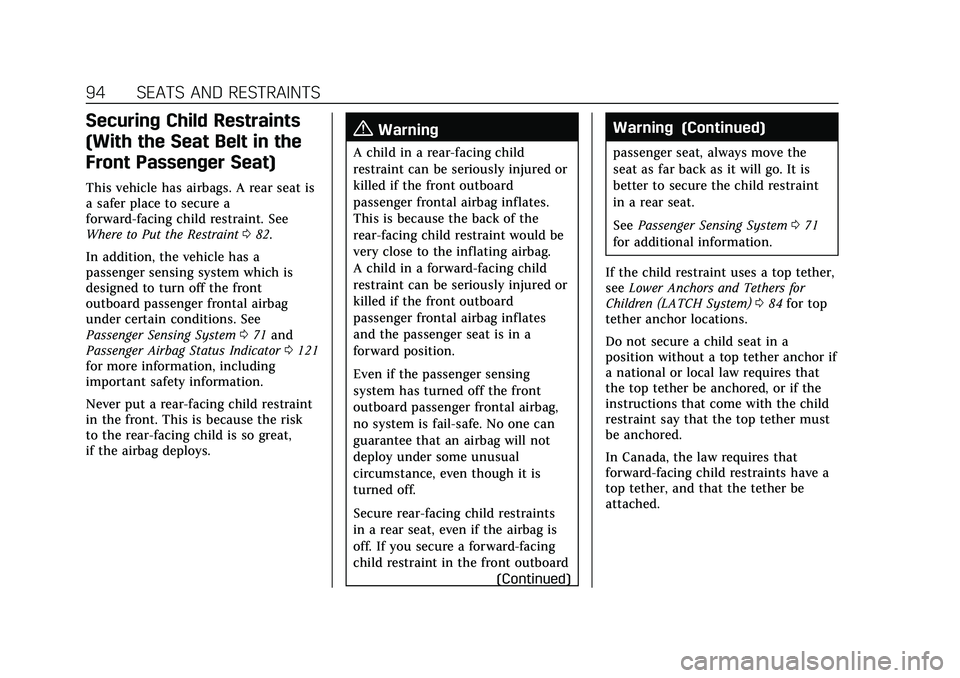
Cadillac Escalade Owner Manual (GMNA-Localizing-U.S./Canada/Mexico-
13690472) - 2021 - CRC - 8/10/21
94 SEATS AND RESTRAINTS
Securing Child Restraints
(With the Seat Belt in the
Front Passenger Seat)
This vehicle has airbags. A rear seat is
a safer place to secure a
forward-facing child restraint. See
Where to Put the Restraint082.
In addition, the vehicle has a
passenger sensing system which is
designed to turn off the front
outboard passenger frontal airbag
under certain conditions. See
Passenger Sensing System 071 and
Passenger Airbag Status Indicator 0121
for more information, including
important safety information.
Never put a rear-facing child restraint
in the front. This is because the risk
to the rear-facing child is so great,
if the airbag deploys.
{Warning
A child in a rear-facing child
restraint can be seriously injured or
killed if the front outboard
passenger frontal airbag inflates.
This is because the back of the
rear-facing child restraint would be
very close to the inflating airbag.
A child in a forward-facing child
restraint can be seriously injured or
killed if the front outboard
passenger frontal airbag inflates
and the passenger seat is in a
forward position.
Even if the passenger sensing
system has turned off the front
outboard passenger frontal airbag,
no system is fail-safe. No one can
guarantee that an airbag will not
deploy under some unusual
circumstance, even though it is
turned off.
Secure rear-facing child restraints
in a rear seat, even if the airbag is
off. If you secure a forward-facing
child restraint in the front outboard
(Continued)
Warning (Continued)
passenger seat, always move the
seat as far back as it will go. It is
better to secure the child restraint
in a rear seat.
SeePassenger Sensing System 071
for additional information.
If the child restraint uses a top tether,
see Lower Anchors and Tethers for
Children (LATCH System) 084 for top
tether anchor locations.
Do not secure a child seat in a
position without a top tether anchor if
a national or local law requires that
the top tether be anchored, or if the
instructions that come with the child
restraint say that the top tether must
be anchored.
In Canada, the law requires that
forward-facing child restraints have a
top tether, and that the tether be
attached.
Page 98 of 492
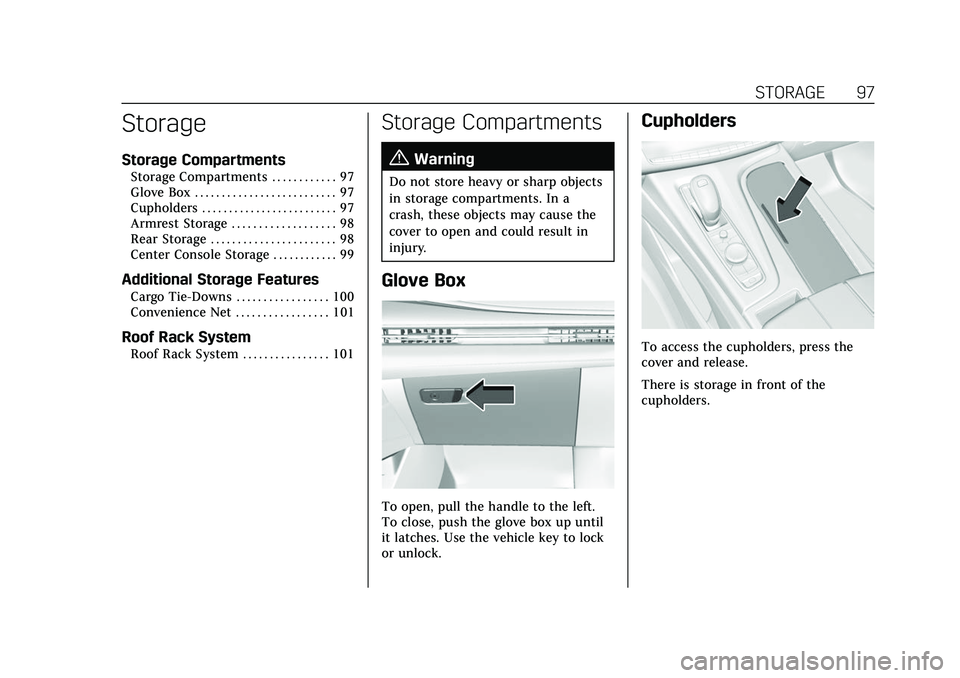
Cadillac Escalade Owner Manual (GMNA-Localizing-U.S./Canada/Mexico-
13690472) - 2021 - CRC - 8/10/21
STORAGE 97
Storage
Storage Compartments
Storage Compartments . . . . . . . . . . . . 97
Glove Box . . . . . . . . . . . . . . . . . . . . . . . . . . 97
Cupholders . . . . . . . . . . . . . . . . . . . . . . . . . 97
Armrest Storage . . . . . . . . . . . . . . . . . . . 98
Rear Storage . . . . . . . . . . . . . . . . . . . . . . . 98
Center Console Storage . . . . . . . . . . . . 99
Additional Storage Features
Cargo Tie-Downs . . . . . . . . . . . . . . . . . 100
Convenience Net . . . . . . . . . . . . . . . . . 101
Roof Rack System
Roof Rack System . . . . . . . . . . . . . . . . 101
Storage Compartments{
Warning
Do not store heavy or sharp objects
in storage compartments. In a
crash, these objects may cause the
cover to open and could result in
injury.
Glove Box
To open, pull the handle to the left.
To close, push the glove box up until
it latches. Use the vehicle key to lock
or unlock.
Cupholders
To access the cupholders, press the
cover and release.
There is storage in front of the
cupholders.
Page 100 of 492
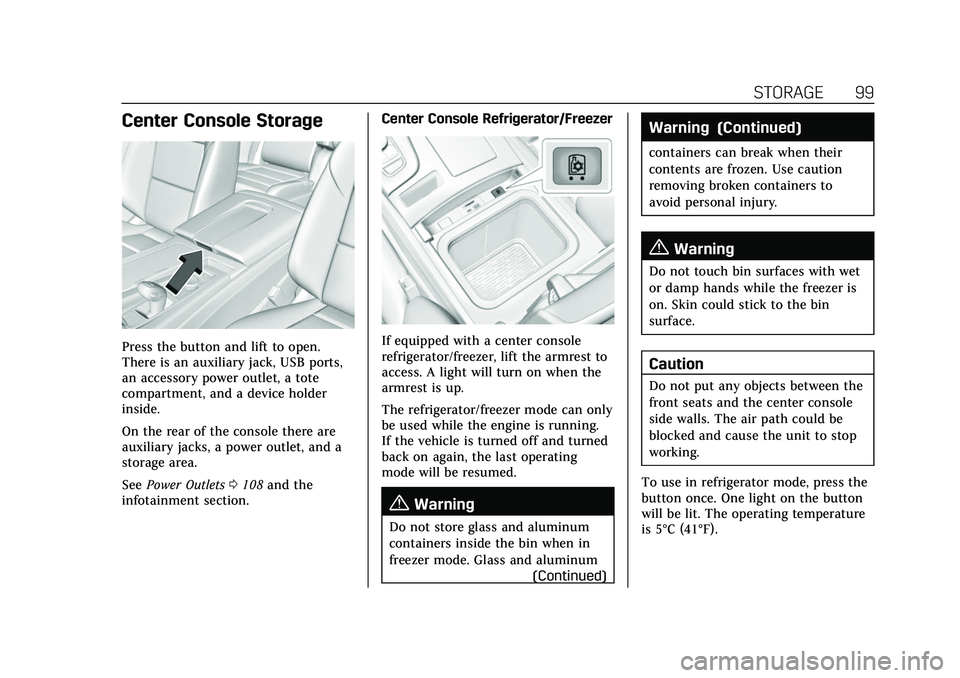
Cadillac Escalade Owner Manual (GMNA-Localizing-U.S./Canada/Mexico-
13690472) - 2021 - CRC - 8/10/21
STORAGE 99
Center Console Storage
Press the button and lift to open.
There is an auxiliary jack, USB ports,
an accessory power outlet, a tote
compartment, and a device holder
inside.
On the rear of the console there are
auxiliary jacks, a power outlet, and a
storage area.
SeePower Outlets 0108 and the
infotainment section. Center Console Refrigerator/FreezerIf equipped with a center console
refrigerator/freezer, lift the armrest to
access. A light will turn on when the
armrest is up.
The refrigerator/freezer mode can only
be used while the engine is running.
If the vehicle is turned off and turned
back on again, the last operating
mode will be resumed.
{Warning
Do not store glass and aluminum
containers inside the bin when in
freezer mode. Glass and aluminum
(Continued)
Warning (Continued)
containers can break when their
contents are frozen. Use caution
removing broken containers to
avoid personal injury.
{Warning
Do not touch bin surfaces with wet
or damp hands while the freezer is
on. Skin could stick to the bin
surface.
Caution
Do not put any objects between the
front seats and the center console
side walls. The air path could be
blocked and cause the unit to stop
working.
To use in refrigerator mode, press the
button once. One light on the button
will be lit. The operating temperature
is 5°C (41°F).
Page 102 of 492
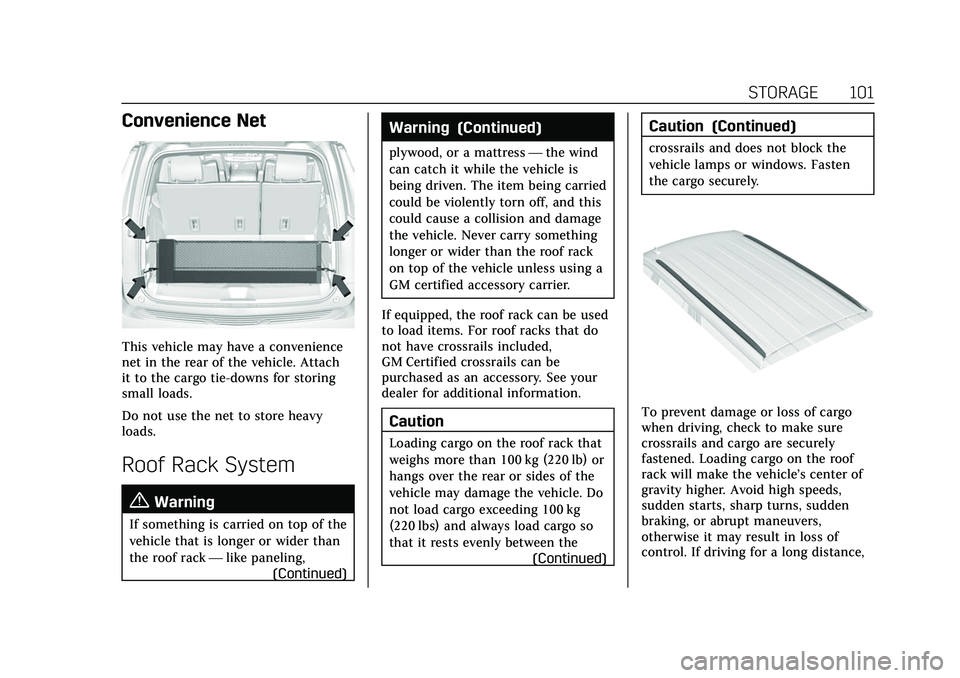
Cadillac Escalade Owner Manual (GMNA-Localizing-U.S./Canada/Mexico-
13690472) - 2021 - CRC - 8/10/21
STORAGE 101
Convenience Net
This vehicle may have a convenience
net in the rear of the vehicle. Attach
it to the cargo tie-downs for storing
small loads.
Do not use the net to store heavy
loads.
Roof Rack System{
Warning
If something is carried on top of the
vehicle that is longer or wider than
the roof rack —like paneling,
(Continued)
Warning (Continued)
plywood, or a mattress —the wind
can catch it while the vehicle is
being driven. The item being carried
could be violently torn off, and this
could cause a collision and damage
the vehicle. Never carry something
longer or wider than the roof rack
on top of the vehicle unless using a
GM certified accessory carrier.
If equipped, the roof rack can be used
to load items. For roof racks that do
not have crossrails included,
GM Certified crossrails can be
purchased as an accessory. See your
dealer for additional information.
Caution
Loading cargo on the roof rack that
weighs more than 100 kg (220 lb) or
hangs over the rear or sides of the
vehicle may damage the vehicle. Do
not load cargo exceeding 100 kg
(220 lbs) and always load cargo so
that it rests evenly between the (Continued)
Caution (Continued)
crossrails and does not block the
vehicle lamps or windows. Fasten
the cargo securely.
To prevent damage or loss of cargo
when driving, check to make sure
crossrails and cargo are securely
fastened. Loading cargo on the roof
rack will make the vehicle’s center of
gravity higher. Avoid high speeds,
sudden starts, sharp turns, sudden
braking, or abrupt maneuvers,
otherwise it may result in loss of
control. If driving for a long distance,